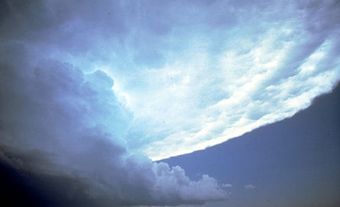Humidity is related to the amount of moisture or water vapour in the air. Although invisible, water vapour is always present in the atmosphere. Its concentration varies from almost zero to a maximum of about 4% by volume.
Water vapour is of great significance to meteorology. Much of what we call weather - clouds, dew, rain, snow, fog and frost - is caused by atmospheric moisture. Water vapour is the only gas that can change into a liquid or solid under ordinary atmospheric conditions, and it is this characteristic that causes most of the weather to develop. We tend to become aware of water vapour when humidity is high because the air feels sticky, clothes feel damp and our skin feels clammy, or when it is low because our lips chap and fly-away hair is hard to manage.
The amount of water vapour that air can hold increases dramatically as the temperature increases. If a specific volume of air at 0° C can hold a cup of water, that same volume of air can hold a half a litre of water at 10° C, a litre at 22° C and 2 litres at 33° C. However, there is a definite upper limit to the amount of water vapour that the air can contain. When this limit is reached for the prevailing temperature, the air is said to be saturated.
Relative Humidity
Several expressions are used to describe the moisture content of air. The most familiar and perhaps the most misunderstood is relative humidity. By definition, relative humidity is the percentage of water vapour that air actually holds compared to what it could hold at that temperature. Stated another way, relative humidity indicates how close air is to being saturated rather than how much water it actually holds. It varies from 100% in clouds and fog to 10% or less over deserts during the day. Air at 22° C can hold approximately 8 g of water vapour per cubic metre (its capacity). If, however, it contains only 4 g, then it is only half-saturated and its relative humidity is 50%.
By itself relative humidity tells nothing about how much water is in the air. A high relative humidity does not necessarily mean a high absolute humidity. A relative humidity of 70% on a day when the temperature is 10° C feels very different from one of 70% on a day when the temperature is 20° C. Except when a change of air occurs, the moisture content of air stays very much the same throughout the day. But not relative humidity. It follows air temperature in about the exactly inverse way - a decrease in temperature results in an increase in relative humidity, and an increase in temperature causes a decrease in relative humidity. On average, the relative humidity is greatest at dawn, during the coolest part of the day, and lowest in midafternoon, when the temperature reaches its maximum. Further, it tends to be greatest in winter and least in summer.
Dew Point
A better absolute indicator of atmospheric moisture content is the dew point, the temperature at which a volume of air must be cooled at constant pressure in order to reach saturation. For example, if the air temperature near the ground is 23° C and the dew point temperature is 13° C, it would be necessary to cool the air 10° C in order to produce saturation. The dew point is entirely independent of the actual air temperature. Therefore, over the course of a summer day, the dew point is unlikely to change much as long as the moisture content remains constant, whereas relative humidity is falling and rising.
As long as the air temperature remains above the dew point, the air is unsaturated; ie, it is capable of holding additional water vapour. If the air cools to its dew point, then the overloaded air gives up some of its excess moisture. It does this by forming clouds, rain or fog or by condensing as dew or frost on cold surfaces, such as grass or on vehicles.
The higher the dew point temperature, the more moisture is in the air. With a dew point of 20° C, most people will feel uncomfortably sticky, even if it means a relative humidity of "only" 50% at 32° C.
Humidex
Over the years, several measures have been proposed to relate various combinations of temperature and humidity into a single number to approximate what hot, humid weather feels like to the average person. Of these, humidex is the one most familiar to Canadians. Humidex was introduced into Canada in 1965. It is calculated with a series of complex formulae using a combination of temperature and humidity levels to provide an indication of the degree of discomfort that will be experienced by the average person. The index is a summer analogue of the wind chill factor in that it is an equivalent air temperature. Air of a given temperature and humidity is equated in comfort to air of a higher temperature that has a negligible moisture content. Comfort is quite subjective and largely dependent on the age and health of the individual. Weather conditions causing prickly heat in an infant may result in heat cramps in a teenager, heat exhaustion in a middle-ager and heat stroke in a senior. Humidex is also limited as an overall hot-weather comfort index because it does not consider other factors such as pressure, wind speed, precipitation, sunshine or pollen.
Prolonged high humidities are unusual in Canada except in southwestern Ontario and on occasion in southeastern Manitoba and southwestern Qué when warm, moist air pushes northward from the Gulf of Mexico and the Caribbean. Generally, humidex decreases with increasing latitude. Humidex values of 45° C or more are rarely observed in Canada. Toronto, for example, has observed a humidex reading equal to or exceeding 45° C for only 2 hours over the past 20 years, and Ottawa for only one hour. Until 2007, the all-time record for humidex rating for Canada was 52.1° C, set on 20 June 1953 at Windsor, Ont. At the time, the temperature was 35° C and the dew point 29° C. That record was broken on 25 July 2007 at Carman, Man, when the temperature was 34° C and the dew point was 30° C, creating a humidex rating of 53° C.
Humidex Extremes Across Canada
| City | Date | Extreme Humidex (C°) |
|
St John's |
06 July 1938 | 38.5° |
| Charlottetown | 15 August 2002 | 41° |
|
Halifax |
21 July 1977 | 42.4° |
|
Fredericton |
10 July 1955 | 44.5° |
|
Montréal |
1 August 1975 | 46.8° |
|
Ottawa |
1 August 2006 | 47° |
|
Toronto |
14 July 1995 | 50.3° |
|
Windsor |
20 June 1953 | 52.1° |
|
Winnipeg |
25 July 2007 | 47.3° |
|
Regina |
24 July 2007 | 48.3° |
|
Saskatoon |
14 July 2002 | 43.9° |
|
Edmonton |
02 August 1965 | 38.7° |
|
Calgary |
13 July 2002 | 36.9° |
|
Vancouver |
20 July 2009 | 38.3° |
|
Victoria |
29 July 2009 | 39.6° |
|
Whitehorse |
29 July 2009 | 33.6° |
|
Yellowknife |
22 July 1997 | 35.4° |
|
Iqaluit |
28 July 2001 | 27.8° |

 Share on Facebook
Share on Facebook Share on X
Share on X Share by Email
Share by Email Share on Google Classroom
Share on Google Classroom


